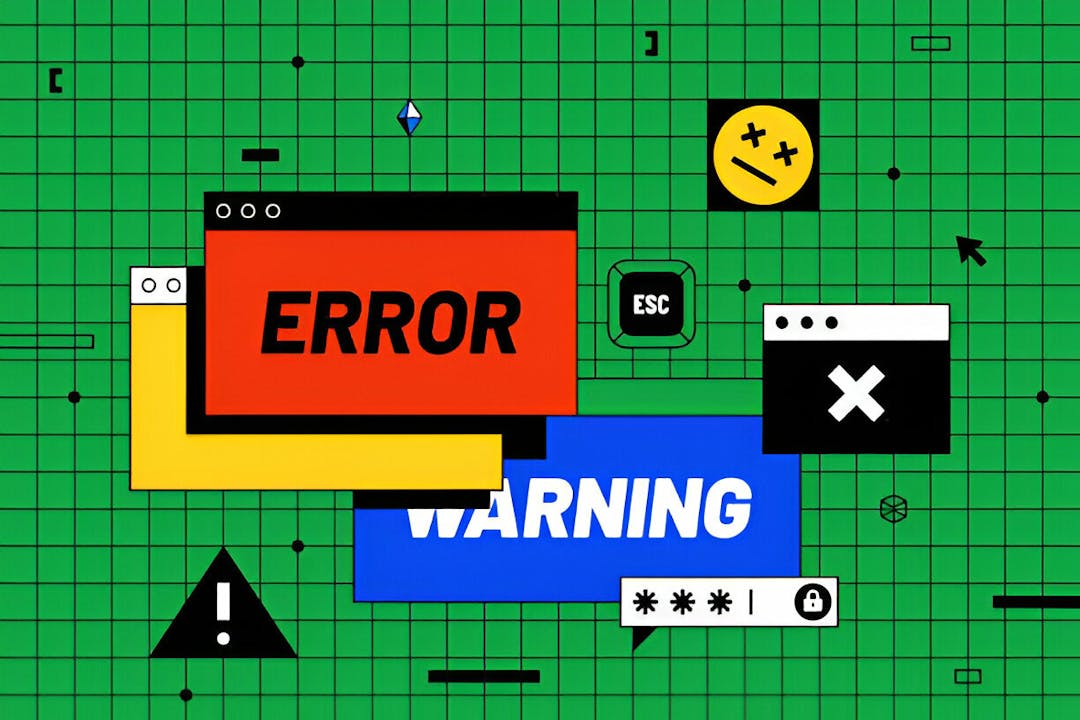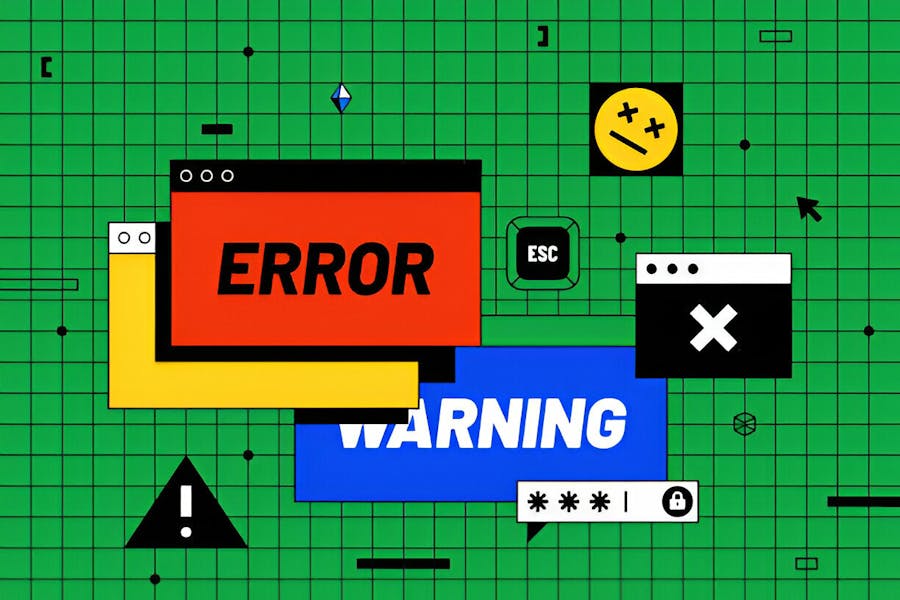
Avoiding Top Website Mistakes: Crucial Strategies to Retain Customers
In the vast expanse of the digital world, having a functional, user-friendly, and visually appealing website is no longer just an option—it's an absolute necessity. Yet, countless business owners find themselves losing customers due to easily avoidable website mistakes. For many businesses, their website is a primary point of engagement with potential clients, making it a critical touchpoint that can convert interest into concrete sales. However, a poorly designed or managed website will often achieve the exact opposite. In this enlightening piece, we delve into the top 10 website mistakes that could be driving your customers away, offering strategic recommendations geared toward enhancing user experience, boosting customer loyalty, and ultimately, increasing your bottom line. Buckle up as we navigate the digital pitfalls hampering your online success.
Poor User Experience (UX)
Poor User Experience or UX is one of the Top 10 Website Mistakes That Are Costing You Customers. A frustrating user experience can drive potential customers away, making it crucial for businesses to focus on creating a smooth and satisfying journey for all users.
Navigation Issues
Navigation plays a crucial role in user experience. When visitors find it hard to navigate through your website, chances are they will leave and likely never return.
Confusing Menu Structure
A confusing menu structure is a common navigation issue. Users should be able to understand the menu and find the necessary pages without any hassle. Menus with too many options or complex layers can be difficult for users to navigate. Also, avoid using jargon or internal terminology in your menu items; use commonly understood words instead.
Missing Search Function
Nothing can be more frustrating for a user than not being able to find specific information on your website. This is where a robust search function comes into play. A missing or poorly functioning search feature is likely to drive users away.
Slow Load Times
Another major reason your website could be losing customers is due to slow load times. Internet users today are accustomed to near-instantaneous loading, and any delay can cause them to abandon your site.
Causes of Slow Load Times
Several factors can contribute to a website's slow loading times. These include servers issues, unoptimized images, too many redirects, or excess use of custom fonts and animations. Identifying and addressing these issues is essential for improving your website's load time.
Note: Evaluation of website load time can be a technical task. Enlist the help of a web developer if you are unfamiliar with this area.
Tools to Test Your Website Speed
Thankfully, various tools can help you measure your website's speed and identify issues contributing to slow loading. These include Google's PageSpeed Insights, GTmetrix, and Pingdom. By running these checks and acting on the insights provided, you can significantly enhance your website's speed and ultimately its user experience.
Improving your site's UX by addressing navigation issues and reducing load times is a surefire strategy to retain more customers and grow your business.
Non-Mobile Friendly Design
The rise in mobile device usage in the last decade underlines the need for web developers to design sites that can conveniently be viewed on smaller screens. A non-mobile friendly design is one of the top website mistakes that are costing you customers since it hampers the user experience significantly.
Importance of Responsive Design
The importance of responsive design cannot be overstated in today's digital world. A responsive website design automatically adjusts layout according to the device screen size and orientation. This offers a seamless browsing experience as users don't have to endlessly pinch, zoom or scroll to view the content.
Moreover, Google prioritizes mobile-friendly websites, improving the site's search engine ranking and visibility. A mobile-responsive design isn't merely an optional addition; it's crucial for ensuring user satisfaction and retention.
Common Mobile Design Mistakes
Numerous businesses fail to understand the specific requirements of mobile users, leading to common mobile design mistakes.
One such misstep is having a cluttered interface with too much information. Mobile screens are smaller, and a clean, clutter-free design works best. Simplifying navigation and ensuring essential features are easily accessible boosts usability.
Another common mistake is using inappropriate font sizes and button sizes. Too small, and users will struggle to read and interact with your site; too large, and important content may get sidelined.
Remember, the goal isn't to shrink your website to fit a smaller screen, but to redesign it to provide an optimized mobile user experience. Avoiding these mistakes ensures the integrity of your website on any device and significantly allows your business to maintain and grow its online audience.
Lack of Clear Call-to-Action (CTA)
One of the significant website mistakes that can be costing you customers is the lack of a clear Call-to-Action (CTA). CTAs are crucial, as they guide your visitors on what steps to take after consuming a piece of content or landing on a page. This might mean signing up for a newsletter, purchasing a product, or filling out a form. Without a transparent and convincing CTA, potential clients might leave your site without making the desired action.
Characteristics of Effective CTAs
Effective CTAs are simple, clear, and compelling. They use convincing language that inspires action and are designed to stand out on the webpage. An influential CTA must have clear language, be concise, and use action words. For example, "Sign Up Now," "Start Your Free Trial Today," or "Add to Cart" are all powerful CTAs that direct users on what to do next. Furthermore, effective CTAs often instill a sense of urgency, encouraging users to act sooner rather than later.
Remember, the goal of a CTA is to garner an immediate response from a visitor. So, you should craft CTAs that are visually distinctive and emotionally stirring, leaving no room for ambiguity about the following action steps.
Placement Strategies
The positioning of your CTA also plays a huge role in its effectiveness. A well-placed CTA could mean the difference between a conversion and a bounce. Hence, your CTA should be located where users will naturally look when they're ready to take action.
Above the Fold: Placing your CTA above the fold (the part of the webpage visible without scrolling) is among the most effective strategies. The reasoning is straightforward: you capture the visitor's attention as soon as they land on your page.
After High-Quality Content: After serving your visitors with compelling and valuable content, they are more likely to comply with your CTA. So, it's wise to put your CTA close to the end of your content.
Persistent CTA: A persistent CTA that stays visible as the user scrolls down the page can also be very effective.
Experiment with different positions, and do what works best for your target audience and site design.
Note: While focusing on CTA placement, also make sure that there's sufficient white space around it to make it stand out, and it doesn't get lost among other components on your webpage.
To recap, a catchy, clear and well-placed CTA can significantly boost your conversions and prevent the loss of potential customers. Thus, while designing or reviewing your website, prioritize crafting and positioning your CTAs effectively.
Poor Website Content
When it comes to the top 10 website mistakes that are costing you customers, poor website content easily finds a spot. Having subpar content on your website can lead to decreased engagement, low conversion rates, and a shaky brand reputation. Let's look into two main aspects under this topic: The importance of quality content and SEO optimization.
Importance of Quality Content
Quality content is one of the key differentiators between your website and millions of others on the internet. High-quality, original content not only captivates your audience but also builds a strong connection with them. This connection generates trust which can turn your visitors into loyal customers or repeat visitors.
Good content provides value to the reader. It's informative, engaging and meets the needs of your audience. Whether it's a blog post, product description, or a simple landing page, all content should be tailored to touch upon your customers' pain points and offer viable solutions.
Moreover, regular updating of content keeps your website fresh and relevant. This signals to users that you're active in your sector, knowledgeable about the latest trends, and ready to cater to their evolving needs. Your audience is much more likely to return to a website that offers fresh, updated content.
SEO Optimization
SEO stands for Search Engine Optimization and it refers to techniques used to increase your website's visibility on search engine result pages. Through effectively optimized content, your site can attract organic traffic from search engines, thus attracting potential customers and improving visibility.
SEO optimization involves the strategic placement of relevant keywords within your content. However, keyword stuffing, an often-mistaken practice, can actually harm your SEO. Instead, focus on creating natural, meaningful content that logically incorporates these keywords.
Another aspect of SEO optimization is the use of meta tags, headers, alt texts for images and an easily readable URL structure. This not only makes your site more accessible for search engines to interpret but also improves your chances of ranking higher in search results.
Moreover, linking internally to other pages within your website and externally to reputable sources can also boost your SEO. This presents your site as a trustworthy and comprehensive resource for users.
In conclusion, lack of quality content and poor SEO optimization are critical mistakes that could cost you customers. By focusing on these areas, you can significantly increase your brand's online visibility, user engagement, and ultimately, conversion rates.
Unattractive Design
One of the top 10 website mistakes that are costing you customers is undeniably an unattractive design. Today, aesthetics play a pivotal role in user experience, and a poorly designed website can drive potential customers away.
Color Choices and Branding
Choosing the right color scheme for your website is paramount. When users visit your website, the colors should immediately align with your brand values and message. However, poor color choices can be off-putting to your visitors. For instance, neon or highly contrasting colors can strain the eyes, leading to reduced on-site time.
Good color choices create a smooth, visual flow, guiding the visitor towards the Call-to-Action (CTA). Inconsistencies in coloring across different web pages may also confuse users about your brand identity. So, choose a color design that is not only appealing but also consistent and reflective of your brand.
Additionally, remember that colors elicit different emotions, influencing users' perceptions and behaviors. Understanding color psychology can guide you in making the right color choices for your website.
Font and Typography Mistakes
Just as with color choices, the importance of choosing the right font type and size cannot be stressed enough. Often, businesses underestimate the impact of typography on website appeal, and this oversight can cost them potential customers.
Here are some common font and typography mistakes:
- Small Font Size: If your text is difficult to read because the font size is too small, users will likely abandon your site in search of one that doesn't strain their eyes.
- Poor Font Choice: Unprofessional or hard-to-read fonts erode trust in your site. Stick to standard, easy-to-read fonts for your content.
- Lack of Contrast: Ensure there's enough contrast between your text and the background color.
- Too Many Different Fonts: Using too many different fonts in your site design can make your website look cluttered and confusing.
In conclusion, having an attractive design for your website is of paramount importance in keeping potential customers engaged. Ensuring the appropriate use of colors and typography should be at the forefront of your website design strategy.
Lack of Trust Elements
One of the common website mistakes your business may be doing is a lack of trust elements. This factor can sharply cut down the number of visitors who convert into loyal customers. Trust elements are crucial for any website because they demonstrate legitimacy and reliability, which, in turn, encourages users to take your desired actions, such as signing up for a newsletter, downloading an ebook, or making a purchase.
Customer Testimonials and Reviews
The absence of customer testimonials and reviews is a significant trust issue. These elements serve as social proof that other users were satisfied with their transactions, giving potential ones the confidence to interact with your website.
Without reviews and testimonials, prospects might question your credibility. Around 92% of customers read online reviews before making a purchasing decision. If your website lacks these, you may be urging them to click off and go to another website that offers more transparency about their experience.
As a business, regularly asking for customers' feedback and featuring positive reviews on your site should be part of your standard operations. This not only boosts trust but also offers valuable insights into what customers value about your offerings.
Security Indicators
Equally essential in building trust are security indicators. Users feel safe navigating and sharing their information on platforms they sense are secure. If your website does not convey a high level of security, it can discourage visitors from engaging further.
Security indicators, such as SSL certificates (visible as the "S" in "HTTPS" in your URL or a padlock in the address bar), show your commitment to protecting users' sensitive information while shopping or sharing personal information on your site. Not having such can raise serious red flags for users and negatively impact your website's reputation and ranking in search engine results.
In nutshell, credibility is the foundation of any online business. Ignoring the incorporation of trust elements like customer testimonials and security indicators can cost you customers and hinder your online growth.
Ineffective Use of Analytics
An alarming mistake most website owners make is the ineffective use of analytics. Analytics involves tracking and evaluating the behavior of visitors to your website. It's one of the pivotal tools to improve and optimize user experience. However, the problem arises when these tools are not used to their full potential, causing loss of potential customers.
Tracking Key Performance Indicators (KPIs)
Primarily, KPIs refer to quantifiable measurements that track the effectiveness of your website. For instance, bounce rate, average session duration, and page views are vital KPIs that demonstrate visitor behavior.
An ineffective tracking of Key Performance Indicators (KPIs) can be a setback for your website's growth. KPIs show you the performance of your website in real-time and help you take quick actions whenever necessary. Not having a clear understanding or tracking your KPIs can often lead to mishandled issues, leaving your website's performance on a teetering edge.
To avoid this, ensure that you have set-up appropriate KPIs to track for your website and routinely check the data. This is integral for maintaining good visitor retention and conversion rates, quite literally, saving you from losing customers.
Note: Some popular tracking tools include Google Analytics, Kissmetrics, Crazy Egg, etc.
Using Data to Improve Conversions
Being ignorant of website data can be one of your biggest mistakes. Data carries a wealth of information and can help tailor your website to meet user needs and preferences.
If utilized effectively, data from analytics can be a game-changer for improving your conversion rates. It'd show you where the visitors are coming from, which pages they are visiting, how much time they are spending, and when they bounce off.
With this valuable information in hand, you can ascertain what works for your website and what doesn't. For instance, if a particular page has a high visitor rate but low conversion rate, it's a clear indication that the page needs reworking. Consequently, optimizing your content and design based on these findings can help enhance user experience, thus improving the conversion rates.
Remember, ignoring your website's data can be costly, hindering you from converting visitors into customers. So, make sure you are making total use of analytics for tracking KPIs and improving conversions.
In conclusion, the proper and effective use of analytics will lead to better decision-making, optimized website experience, and ultimately, happier customers. Don't let these website mistakes cost you your valued customers.
Missing or Incomplete Contact Information
One of the most significant website mistakes that could be costing you customers is missing or incomplete contact information. Users visiting your website might already be interested in your products or services. But, if the contact details provided are fuzzy or entirely absent, you risk frustrating potential customers who then might search elsewhere.
Optimal Placement of Contact Details
Deciding on the optimal placement of contact details can be a bit of a balancing act. It should be readily accessible without being intrusive to the overall website design. Incorporating contact details in the header or footer can work great. Elsewhere, having a distinct 'Contact Us' page, where visitors know they can find such information, is a standard practice.
It's crucial to recognize that different users may prefer different channels of communication. Be a defect in your product, a question about your services, or a grievance, when customers reach out to you, they expect to be directed to the right department without unnecessary jostling around.
Note: Placing your contact information also boosts your site's credibility besides being a convenience aspect.
Offering Multiple Contact Methods
Offering multiple contact methods can ensure that you cater to a wide variety of customer preferences. It shows that you respect their preferred mode of communication, which goes a long way in enhancing user experience. When offering multiple contact methods, consider including email addresses, telephone numbers, physical addresses (if relevant), and even your social media links.
Another forward-thinking strategy is incorporating a live chat feature. Many users appreciate the real-time and personal touch that live chats offer. Also, providing an option to schedule a call or meet can be helpful for users operating in different time zones or those with specific inquiries.
In conclusion, accessible and diverse contact information is an often-overlooked feature of a website that conveys customer-centricity. By rectifying this common mistake, you can avoid losing potential customers and instead enhance user experience, build confidence in your services, and improve conversion rates.
Lack of Social Media Integration
One of the key website mistakes that are costing you customers is the lack of social media integration. Now more than ever, consumers are spending a significant portion of their day on social media platforms. From Facebook to Instagram, to Twitter, and beyond - ignoring these platforms can ultimately harm your business, causing significant loss of potential revenue and reach.
Benefits of Social Media Links
Implementing social media links on your website comes with numerous benefits that should not be overlooked. Firstly, it fosters a connection between your brand and the customer on a more personal level.
Note: There are over 2.8 billion monthly active users on just Facebook alone.
By integrating these links, it offers an opportunity for potential customers to view your brand in a more social and relaxed environment, possibly encouraging them to engage more with products or services.
Another major benefit is the increase in your website's traffic. Social media posts and updates can directly lead back to your website, meaning more eyes on your products and services. And, of course, the more traffic your website sees, the higher the potential for leads, conversions, and sales.
Lastly, social media links can greatly boost your SEO. Search engines like Google now acknowledge social media behavior, meaning that active social media links can push your website up the rankings.
Encouraging User Interaction
Social media links alone aren't enough - encouraging user interaction is key. Actively engaging with your customers through comments, shares, and likes can greatly enhance brand loyalty and customer satisfaction.
But how do you catalyze this interaction? There are a variety of strategies that you can employ.
For instance, running social media contests can be a great way to boost engagement. This also provides an opportunity for your brand to go viral, thus widening brand awareness.
Similarly, posting quality content that resonates with your audience is another way to spur interaction. This can range from educational blogs, thought leadership pieces, or simply sharing fun and relatable content.
Do not underestimate the power of social media integration when it comes to retaining and attracting new customers! Making the most of these platforms can give your business a major boost.
Ignoring Accessibility Standards
Ignoring accessibility standards is one of the top website mistakes that are costing you customers, and it's a prevalent problem that many firms fail to address.
Importance of Web Accessibility
Web accessibility is a critical aspect of any online platform, and its significance extends beyond mere moral grounds or legal obligations. In the first place, ensuring your website is accessible to everyone, including individuals with disabilities, enlarges your customer base. The World Health Organization estimates that more than a billion people globally have some form of disability, highlighting the size of this often-ignored market sector. Furthermore, optimizing your website for accessibility improves its usability for all users, not just those with disabilities, which can translate into higher conversion rates and customer satisfaction. Lastly, since accessibility is a component of many SEO algorithms, neglecting it can harm your website's search rankings.
Common Accessibility Mistakes
When it comes to accessibility, many websites make common mistakes that impede navigation and functionality for certain users. First, lack of alt text for images is a typical issue. Alt text provides a description of an image for users who cannot see it, such as individuals using screen readers. Without it, the content of your site can be confusing or meaningless.
Another common mistake is poor contrast between the text and its background, making it difficult or impossible for users with visual impairments to read. Lack of keyboard functionality is another common issue, preventing those who rely on keyboards instead of mice or touch screens from navigating your site.
Finally, many websites fail to provide transcripts for audio or captions for video content, making their content inaccessible to those who are hard of hearing. By avoiding these common accessibility mistakes, you can make your website more inclusive and user-friendly, leading to increased customer retention and satisfaction.
Is Your Website Costing You Customers?
A slow, outdated, or confusing website can drive potential customers away. Learn how to fix the most common website mistakes and turn visitors into loyal clients.




